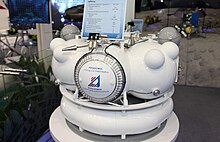 Model of Fregat at MAKS Airshow, 2013 | |
| Manufacturer | NPO Lavochkin |
|---|---|
| Country of origin | Russia |
| Used on | Soyuz-U (retired), Soyuz-FG (retired), Soyuz-2, Zenit-3F |
| General characteristics | |
| Diameter | Fregat/Fregat-M: 3.35 m (11.0 ft) Fregat-MT: 3.80 m (12.5 ft) Fregat-SB: 3.875 m (12.71 ft) |
| Length | 1.5 m (4 ft 11 in) |
| Propellant mass | Fregat: 5,250 kg (11,570 lb) Fregat-M: 5,600 kg (12,300 lb) Fregat-MT: 7,100 kg (15,700 lb) |
| Empty mass | Fregat: 930 kg (2,050 lb) Fregat-M: 980 kg (2,160 lb) Fregat-MT: 1,050 kg (2,310 lb) |
| Associated stages | |
| Comparable | Briz-M, Briz-KM |
| Fregat | |
| Powered by | S5.92 |
| Maximum thrust | 19.85 kN (4,460 lbf) |
| Specific impulse | 333.2 seconds |
| Burn time | 1,350 seconds[2] |
| Propellant | N2O4/UDMH |
| Launch history | |
| Status | Active |
| Total launches | 111 |
| Successes (stage only) | 108 |
| Failed | 2 |
| Other | 1 (partial failure) |
| First flight | 2 February 2000 |
Fregat (Russian: Фрегат, lit. 'frigate') is an upper stage developed by NPO Lavochkin in the 1990s, which is used in some Soyuz and Zenit launch vehicles, but is universal and can be used as a part of a medium and heavy class launch vehicles. Fregat became operational in February 2000.[3] Its liquid propellant engine uses UDMH and N2O4. Fregat's success rate is 97.3%, (with two failures and one partial failure), which makes it one of the most reliable upper stages in the world. Fregat has successfully delivered more than 300 payloads into different orbits. It remains the only upper stage in the world that can place its payload into three or more different orbits in a single launch.[4]
- ^ "Конструкция разгонного блока "Фрегат"". NPO Lavochkin (in Russian). Archived from the original on 26 December 2015. Retrieved 10 March 2016.
- ^ "Fregat space tug". RussianSpaceWeb. Retrieved 26 July 2014.
- ^ "Cluster II on track after maiden flight of Fregat upper stage". 9 February 2000.
- ^ "Photo-Report from Lavochkin Scientific and Production Association, One Day at Fregat Upper Stage Manufacturing Facility". Archived from the original on 11 September 2021. Retrieved 11 March 2020.